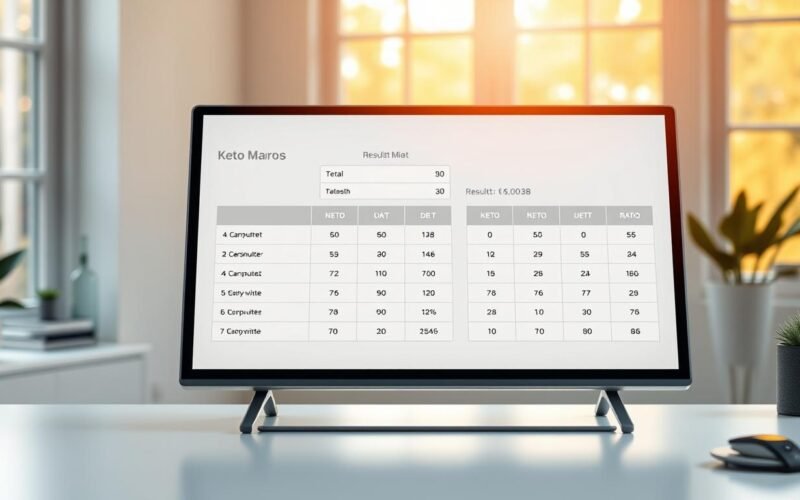Did you know 70% of people on a ketogenic diet see big weight loss results? Finding the right balance in keto can be tough. But, the keto macros calculator makes it easier. It helps you fine-tune your diet to the last detail.
In 2025, it’s not just about counting calories. It’s about getting the right mix of fats, proteins, and carbs. This balance is key to a successful keto diet.
A keto nutrition calculator looks at your age, gender, how active you are, and your health goals. It uses formulas like the Mifflin-St. Jeor Formula to figure out your macro needs. This personal touch is vital for reaching your goals, like losing weight or building muscle.
Explore the world of macros and see how a ketogenic diet calculator can help you on your path to better health.
Introduction to Keto Macros
Starting a ketogenic diet means learning about macronutrients (macros). The goal is to make your body burn fat for energy instead of carbs. To do this, you need to calculate macros for keto carefully and manage them well.
What Are Macros?
Macros, short for macronutrients, are the main parts of any diet. They include fats, proteins, and carbs. Each one has a special role in how our bodies work:
- Fats: They are a big energy source and help cells grow.
- Proteins: They fix muscles, boost the immune system, and make hormones.
- Carbohydrates: They give quick energy but are limited in a keto diet to keep ketosis.
It’s key to balance these macros for a keto diet to stay healthy and perform well. For example, a study by Factor Meals showed people lost 8 lbs in 8 weeks by sticking to their macro ratios.
Importance of Macros in a Keto Diet
The heart of a keto diet is changing your macronutrient mix. It usually means:
- 75% fat
- 20% protein
- 5% carbohydrates
This mix helps your body go into ketosis. A macronutrient calculator is useful to keep your intake right, which is key for staying in ketosis.
For instance, a 30-year-old, moderately active woman who weighs 180 pounds and eats 1908 calories a day needs certain macros:
| Macro | Amount | Percentage |
|---|---|---|
| Protein | 126 grams | 27% |
| Fat | 145 grams | 69% |
| Carbs | 24 grams | 5% |
Getting your macros right is key for a successful keto diet. By watching your intake, you’ll keep ketosis and enjoy better weight loss, hunger control, and more energy.
Understanding Keto Macronutrients
Starting a ketogenic diet means knowing about macronutrients like carbs, protein, and fat. These nutrients are key for staying in ketosis, keeping muscles healthy, and having enough energy. A keto diet tool is very helpful for tracking these macros.
Role of Carbs in Keto
Carbs are limited in a keto diet to help you enter ketosis. They should make up less than 5% of your daily calories. For most, this means eating less than 20 to 50 grams of carbs daily. Your exact limit depends on how many calories you need.
- Under 2,000 calories/day: 20 grams of carbs or less
- 2,000 to 2,500 calories/day: 25 to 30 grams of carbs or less
- 2,500 to 3,000 calories/day: 30 to 35 grams of carbs or less
- Over 3,000 calories/day: 35 to 50 grams of carbs or less
Importance of Protein
Protein is vital for muscle repair and growth. On a keto diet, it should be about 20%-25% of your daily calories. Adjust your protein intake based on your activity level to avoid losing muscle. Here are some guidelines:
- Sedentary: 0.6 grams per pound of body weight per day
- Moderately Active: 0.9 grams per pound of body weight per day
- Very Active: 1.1 grams per pound of body weight per day
The Critical Contribution of Fat
Fat is the main part of a keto diet, making up 70%-80% of your daily calories. It not only gives you energy but also helps absorb important nutrients. Here’s a simple example to understand:
- 20 grams of carbs provide 80 calories
- 150 grams of protein provide 600 calories
- 124 grams of fat are needed for 1,120 calories
So, a typical keto diet is 5% carbs, 33% protein, and 62% fat. A ketogenic macro calculator can adjust these numbers for you. This ensures your diet stays effective and helps manage your weight.
How to Calculate Your Keto Macros
To follow a ketogenic diet, you must calculate your keto macros correctly. First, find out your Total Daily Energy Expenditure (TDEE). This is based on your age, weight, sex, activity level, and body composition.
After finding your TDEE, use a keto macro calculator online to make it easier. A ketogenic diet is mostly fats (70-80%), with some protein (15-25%) and carbs (5-10%). Here’s a detailed look:
| Macro | Percentage Range | Calories/Gram |
|---|---|---|
| Carbohydrates | 5-10% | 4 |
| Protein | 15-25% | 4 |
| Fats | 70-80% | 9 |
Knowing how much carb you need for ketosis is key. Aim for less than 30g of net carbs daily. This can change based on your size and activity level. Net carbs are total carbs minus fiber and sugar alcohols.
Protein is also important for muscle and health. A moderately active person should eat about 0.9 grams of protein per pound of body weight. For example, a 150-pound person needs about 135 grams of protein daily. This amount can go up on more active days.
Let’s figure out daily protein needs step by step:
- Weight in pounds multiplied by the protein factor based on activity: 150 pounds x 0.9 grams = 135 grams of protein/day
Fats are also key for energy on keto. To find your fat needs, subtract carbs and protein calories from your total calories. Then divide the remaining calories by 9. Here’s how:
- For an 1,800-calorie plan: Calories from carbs (20g) = 20g x 4 = 80 calories; Calories from protein (135g) = 135g x 4 = 540 calories
- Remaining calories for fats: 1,800 – 80 – 540 = 1,180 calories
- Grams of fat needed: 1,180 / 9 = approximately 131 grams of fat/day
By grasping these concepts, you can use a keto macro calculator online. This helps tailor your diet to your needs, making it easier to enter ketosis and lose weight.
Why TDEE Calculation Matters
Understanding Total Daily Energy Expenditure (TDEE) is key to starting your ketogenic diet. It helps you set dietary goals and track calorie intake. This way, you can reach your fitness goals more easily.
Defining TDEE
TDEE is the total calories your body needs to keep its weight. It includes all daily activities. It’s based on:
- Basal Metabolic Rate (BMR): The energy your body uses when you’re resting.
- Non-Exercise Activity Thermogenesis (NEAT): Calories burned from daily activities not counting exercise.
- Thermic Effect of Food (TEF): Energy spent on digesting and absorbing food.
- Exercise Activity (EA): Calories burned from physical exercise.
How TDEE Affects Your Macros
Knowing your TDEE helps you adjust your macros better. For weight loss, aim for a 250-330 calorie deficit daily. This leads to losing about 1 pound a week.
To build muscle, you might need to eat more. Increase your intake by 10-to-12 calories per pound of body weight.
Activity levels are also important:
- Sedentary: Multiply BMR by 1.2.
- Lightly Active: Multiply BMR by 1.375.
- Moderately Active: Multiply BMR by 1.55.
- Very Active: Multiply BMR by 1.725.
- Extra Active: Multiply BMR by 1.9.
It’s important to check your TDEE often. Your body and activity levels can change. The best keto calculator helps set your macros for better results on your keto journey.
Keto Macro Breakdown: Key Ratios Explained
The ketogenic diet is famous for its special macro ratios. These ratios are key to getting and staying in ketosis. They help you burn fat better and keep your muscles strong. Here’s a detailed look at the important keto macro ratios and protein needs for anyone using a keto macro tracker.
Fat to Carb Ratios
A good keto diet has lots of fat and very few carbs. It should have 70-80% of calories from fats, 20-30% from protein, and just 5% or less from carbs. Keeping carbs under 20-50 grams a day is important to stay in ketosis. Beginners should aim for 20-25 grams a day.
| Calories/Day | Carbs (g) | Fats (g) | Protein (g) |
|---|---|---|---|
| Less than 2,000 | 20 or less | 156-178 | 100-150 |
| 2,000 to 2,500 | 25-30 | 172-200 | 125-188 |
| 2,500 to 3,000 | 30-35 | 195-240 | 150-225 |
| More than 3,000 | 35-50 | 210-260 | 175-250 |
Protein Requirements
Protein is important in a keto diet to avoid losing muscle and to burn fat. The amount of protein you need depends on your weight and how active you are. Sedentary people should aim for 0.6 grams of protein per pound of body weight. Moderately active people need 0.9 grams per pound, and very active people need 1.1 grams per pound.
For example, a 150-pound person who is moderately active should eat about 135 grams of protein a day (150 x 0.9).
This balanced approach makes sure your keto diet is effective and meets your fitness goals.
Keto Macro Chart: Visual Guide
A keto macro chart is a key tool for those on the ketogenic diet. It shows the balance of fats, proteins, and carbs needed for your diet.
Getting the right nutrient ratios is key to staying in ketosis and reaching your health goals. The keto diet requires tracking macronutrients closely. This ensures you meet intake levels without going over carb limits.
| Activity Level | Protein per Pound of Lean Body Mass | Carbs per Day | Fat Percentage of Total Calories |
|---|---|---|---|
| Sedentary | 0.6 grams | 20-30 grams | 60-75% |
| Lightly Active | 0.7-0.9 grams | 20-30 grams | 60-75% |
| Moderately Active | 0.8-1.0 grams | 20-30 grams | 60-75% |
| Very Active | 1.0-1.2 grams | 20-30 grams | 60-75% |
| Athletes/Bodybuilders | 1.2 grams | 20-30 grams | 60-75% |
These guidelines suggest daily protein intake should be 0.7 to 1.2 grams per pound of lean body mass. Your activity level determines this. Carbs should not exceed 30 grams daily to stay in ketosis. Fat should make up 60-75% of your calories.

Using a keto diet macro calculator makes managing these numbers easier. This visual guide helps keep your ketogenic diet on track. It ensures you reach your health goals.
Keto Macros Calculator: A Complete Guide
Using a keto macros calculator is key for those on a ketogenic diet. It gives you a diet plan based on your height, weight, age, and how active you are. This tool helps you get the right amounts of macronutrients, making it easier to follow your diet and improve your health.
Benefits of Using a Keto Macros Calculator
The best keto macro calculator has many benefits for your keto journey:
- It helps you target the right macronutrients for ketosis by using your unique data.
- It supports your weight goals, whether you want to lose, maintain, or gain muscle.
- It keeps you on track with real-time, personalized advice, making it easier to stick to the diet.
- It improves your metabolic health by helping you burn fat more efficiently.
How to Use the Calculator
To start with a free keto macro calculator, just follow these easy steps:
- Enter your personal details: Put in your height, weight, age, and activity level. This helps the calculator figure out your daily energy needs.
- Set your dietary goals: Pick if you want to lose, maintain, or gain weight. You can also adjust your calorie intake as needed.
- Adjust macronutrient ratios: The calculator suggests a typical keto diet ratio. You can change these to fit your needs.
- Review your daily macro breakdown: After inputting your data, you’ll see how many calories you get from fat, protein, and carbs each day.
Here’s an example of a daily macro breakdown for a 35-year-old female who’s moderately active. She’s 5 feet 5 inches tall and weighs 140 pounds, with a TDEE of 2,063 calories:
| Goal | Carbohydrates | Protein | Fat |
|---|---|---|---|
| Maintain | 103 calories (approximately 26 grams) | 516 calories (approximately 129 grams) | 1,444 calories (approximately 160 grams) |
| Lose Weight | 78 calories (approximately 20 grams) | 391 calories (approximately 98 grams) | 1,094 calories (approximately 122 grams) |
With a free keto macro calculator, making your keto diet fit your needs is easy. It helps you stay on track and reach your health goals.
Best Tools for Keto Macro Tracking
Tracking your macronutrients is key for a successful ketogenic diet. A reliable keto macro calculator app makes this easy and accurate. Here are some top tools:
MyFitnessPal
MyFitnessPal is a top app (4.7 on iOS, 4.5 on Android) with over 6 million food items. Its premium version, at $9.99 a month, has cool features like a barcode scanner for over 4 million products. It helps you keep track of your keto macros easily.
Carb Manager
Carb Manager is a top keto macro calculator app (4.8 on iOS, 4.7 on Android) for low-carb fans. It has over 1 million food items and 350,000 low-carb recipes. The premium version costs $39.99 a year.
Cronometer
Cronometer is also great, rated 4.7 on iOS and 4.6 on Android. For $5.99 a month, the premium version gives detailed nutrition analysis and connects with fitness devices. Its detailed food logging helps keep your keto diet on track.
These tools are vital for anyone on a ketogenic diet. Picking the right keto macro calculator app can greatly improve your health and well-being.
Embedded Keto Macro Calculator for Quick Results
Having an easy keto macro calculator in your favorite app or website is a big deal. Millions of people use the free keto macros calculator to track their macros and calories. It helps them with weight loss, muscle gain, or just staying healthy.
The best thing about an easy keto macro calculator is how it can be tailored just for you. You can change your daily food intake based on how active you are or your diet goals. It suggests eating 80% of minimally processed foods and 20% of indulgent foods.
Keto Macro Calculator (Please click here and check your Macro)
Track your macros along with our Body Fat Calculator and check BMI Calculator for Keto.
This tool is easy to use and doesn’t need to be downloaded. It’s perfect for most people who are not very active. It offers three calorie deficit levels: mild, moderate, and painful. Most people find the moderate level the most comfortable and sustainable.
Free keto macros calculators also let you adjust your carb intake. This is important if you change how active you are. People have lost a lot of weight, some even 75 lbs or more in just 21 months.
| Feature | Benefit |
|---|---|
| Personalized Macro Calculation | Based on individual goals |
| Simple, App-Free Access | Enhances usability |
| Three Levels of Calorie Deficit | Provides tailored fat loss strategies |
| Sync with Macro Sync App | Easy tracking post-calculation |
Research shows that a ketogenic diet can lead to fast weight loss. You might lose up to 10 pounds of water weight in just a few weeks. The embedded macro calculator helps users stick to their keto diet for health or weight goals.
How to Tailor Your Keto Macros with Apps
Optimizing your ketogenic diet is easier with the right tools. Apps for the keto lifestyle offer features to customize macronutrient goals. They help track dietary intake and keep you on track. These tools use a macro calculator for ketogenic diet to meet your nutritional needs.
Customization Features
Keto diet apps have customization features for your dietary plan. For example, Carb Manager lets you set macro goals for carbs, fats, and proteins. You can input your height, weight, and goal weight for daily targets.
Adjustments can be made for activity levels. This flexibility helps you maintain or change your diet as needed.
Tracking Consistency
Tracking is key for a ketogenic diet, and apps provide the structure needed. Logging daily food intake helps stay within macro limits. Apps like MyFitnessPal, Cronometer, and Carb Manager track macros and offer barcode scanning for quick logging.
They also monitor additional metrics like fiber, fats, cholesterol, vitamins, and minerals. This balance is essential for ketosis.
Below is a comparison table highlighting key features of popular keto macro tracking apps:
| App | Customization | Tracking Consistency | Premium Features |
|---|---|---|---|
| MyFitnessPal | Macro adjustments based on goals | Barcode scanning, daily logging | Detailed nutrient tracking |
| Carb Manager | Custom macro goals, adjusts based on weight | Net carb tracking, photo logging | Intermittent fasting, carb cycling |
| Cronometer | Custom macro and micronutrient targets | Comprehensive nutrient tracking | Advanced metrics, extended data reports |
Using a macro calculator for ketogenic diet in these apps helps customize and track keto macros. This leads to better adherence and successful outcomes.
Practical Tips for Achieving Keto Success
To succeed on a ketogenic diet, follow key steps. These steps help you stay on track and keep the right balance of nutrients. We’ll explore meal planning, consistency, and tracking progress to reach your keto goals.
Meal Planning
Meal planning is essential for a keto diet. Make sure your meals have 70-75% fat, 20-25% protein, and 5-10% carbs. This balance keeps you in ketosis.
Plan your meals to avoid unexpected changes. Include low-carb veggies like spinach and kale for vitamins and minerals. Keep a stock of keto-friendly foods like cheeses and avocados.
Staying Consistent
Consistency is key for diet success. A keto diet tool helps you stick to your diet. Track your macros to avoid too much protein or not enough fat.
Use keto-friendly snacks like ZonePerfect® Keto shakes for busy days. Drinking at least 8 glasses of water daily is also important for hydration and health.
Monitoring Progress
Keep an eye on your progress with body metrics and health signs. Use a keto diet tool to track weight, measurements, and overall health. This helps adjust your diet as needed.
For example, a 150-pound person might need 135 grams of protein daily for muscle maintenance. Regular checks ensure you stay in the right carb and fat ranges, like less than 50 grams of carbs per day.
In summary, practical tips like meal planning, consistency, and tracking progress are vital for keto success. By following these strategies, you can stay on track and achieve your health goals.
Conclusion
The ketogenic diet calculator is a must-have for anyone starting or staying on a ketogenic diet. It helps you set the right amounts of carbs, proteins, and fats for your goals. This is key for losing weight or improving your metabolic health.
Keeping track of your keto macros is vital for lasting success. A diet calculator makes it easier to stick to your diet and reach your goals. Tools like MyFitnessPal, Carb Manager, and Cronometer help by letting you customize and monitor your diet closely.
Good meal planning, consistent tracking, and regular progress checks can greatly improve your keto diet’s success. It might take a few weeks to get used to a keto lifestyle. But with the right tools and commitment, a ketogenic diet calculator can lead you to a healthier, more balanced life.




